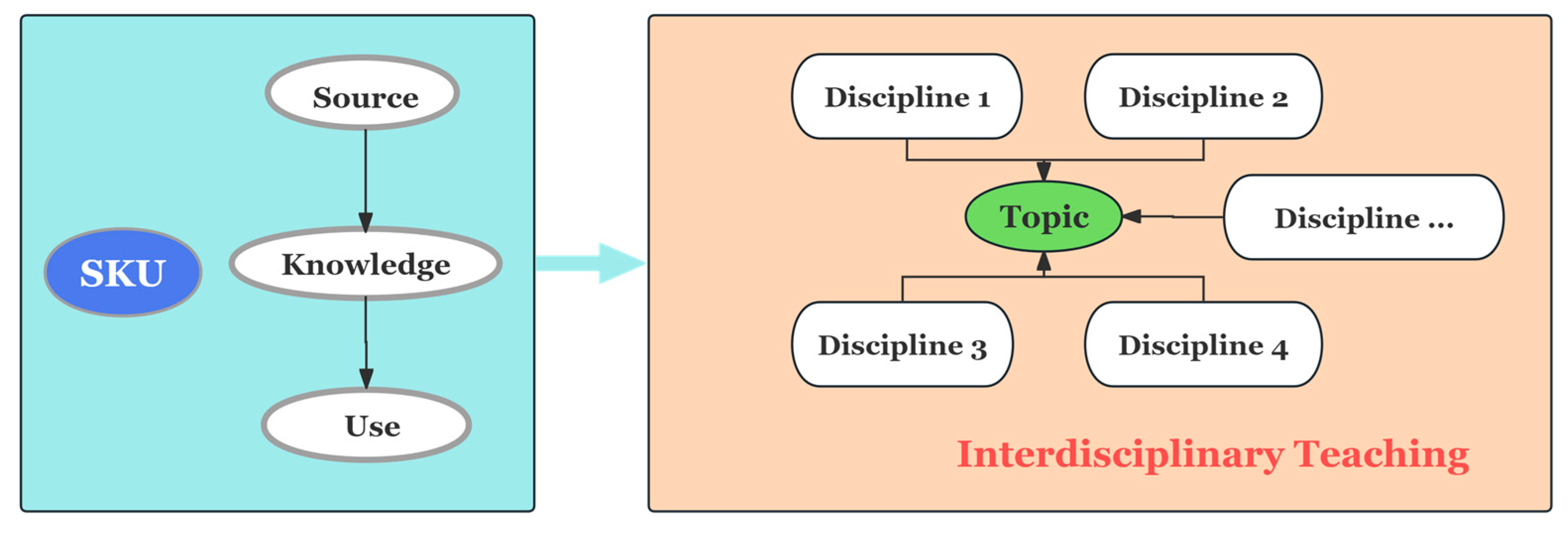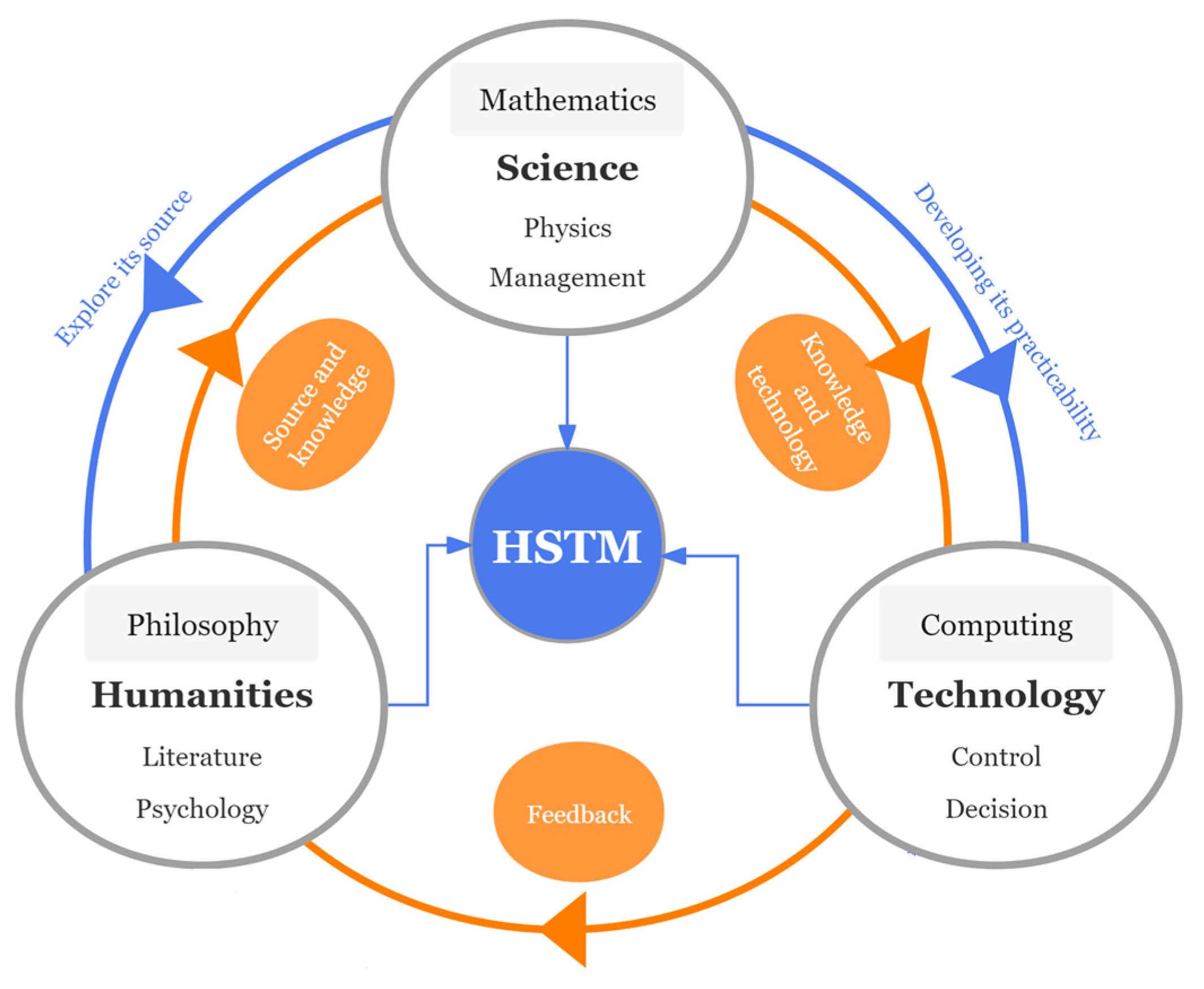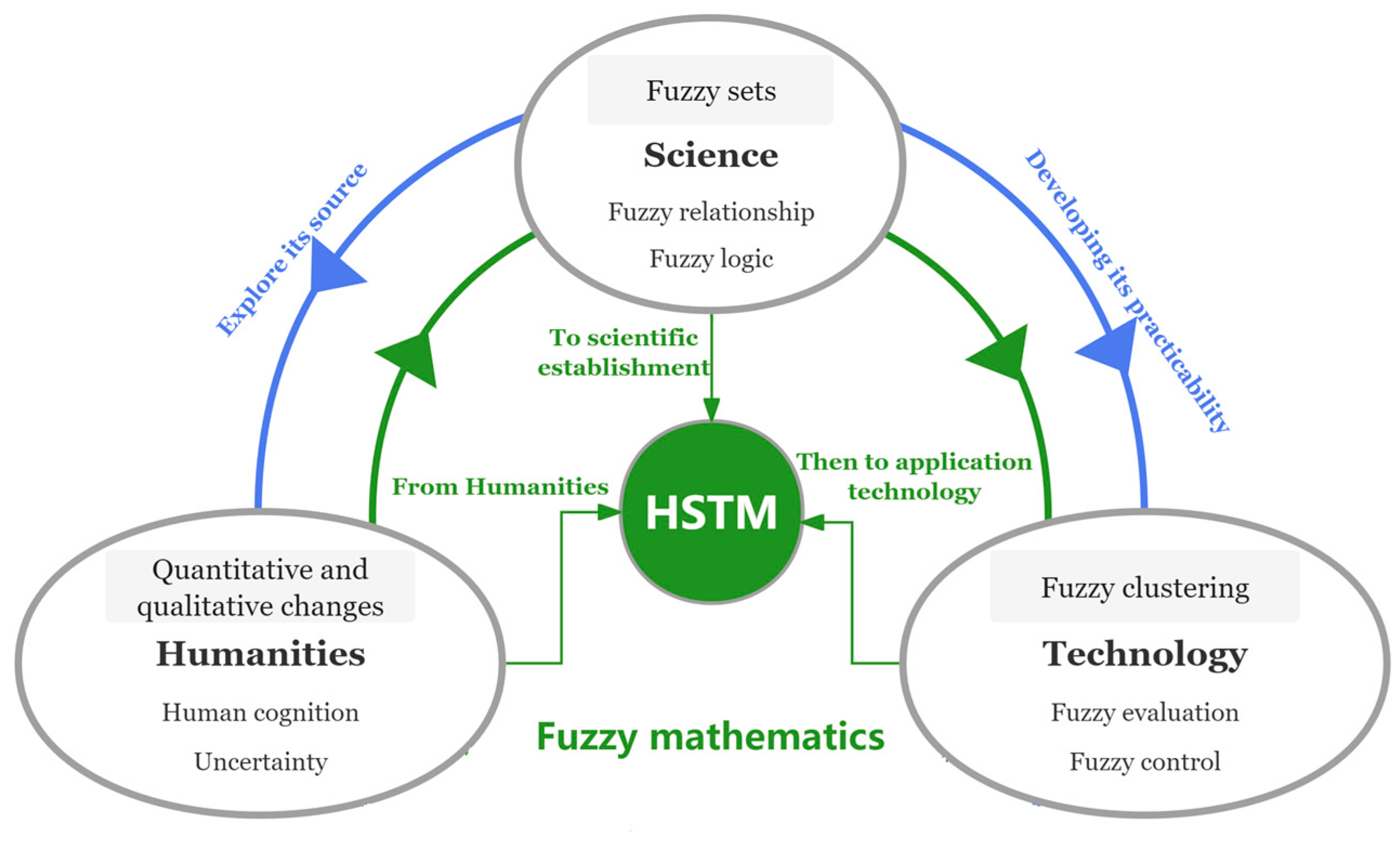The Source–Knowledge–Use-Based Interdisciplinary Teaching Framework for Enhancing Sustainability: A Humanities–Science–Technology Model for Fuzzy Mathematics as a Case
Abstract
:1. Introduction
1.1. Background
1.2. The Objective of This Study
2. Concepts and Model
2.1. Interdisciplinary Teaching and Source–Knowledge–Use (SKU)
2.2. Humanities–Science–Technology Model (HSTM)
3. HSTM for Fuzzy Mathematics
3.1. The Interdisciplinary Nature of Fuzzy Mathematics
3.1.1. The Humanistic Background of Fuzzy Mathematics
3.1.2. The Scientific Value of Fuzzy Mathematics
3.1.3. The Technical Application of Fuzzy Mathematics
3.2. The Framework and Contents of HSTM for Fuzzy Mathematics
3.2.1. The Basic Framework
3.2.2. Humanistic Dimension Content
3.2.3. Scientific Dimension Content
3.2.4. Technical Dimension Content
3.3. The Implementation of HSTM for Fuzzy Mathematics
4. Challenge and Countermeasure
4.1. Construction of a Diversified Evaluation System
4.2. Organic Integration of Course Resources
4.3. Enhancing the Interdisciplinary Ability of the Teaching Team
5. Conclusions
- (1)
- Interdisciplinary teaching is one of the most important ways to promote the sustainable development of education, but its interdisciplinary consideration based on knowledge itself is still insufficient, and it needs to change from “solving specific problems” to “forming a universal basic paradigm”;
- (2)
- By considering the humanistic background and development source of scientific knowledge, exploring the establishment process of its system, and then how to use the knowledge for technical application, we established the framework of SKU teaching, which is conducive to promoting the deepening of interdisciplinary education;
- (3)
- Fuzzy mathematics possesses excellent interdisciplinary capabilities. From humanities to science and then to technology, it is crucial to develop an HSTM teaching mode. However, it faces numerous challenges that need to be addressed from various aspects, such as resource reconstruction, teacher training, and multiple assessments.
Author Contributions
Funding
Institutional Review Board Statement
Informed Consent Statement
Data Availability Statement
Conflicts of Interest
References
- Niu, W.Y. The Theoretical Connotation of Sustainable Development: The 20th Anniversary of UN Conference on Environment and Development in Rio de Janeiro, Brazil. China Popul. Resour. Environ. 2012, 22, 9–14. [Google Scholar]
- Aleixo, A.M.; Leal, S.; Azeiteiro, U.M. Higher education students’ perceptions of sustainable development in Portugal. J. Clean. Prod. 2021, 327, 129429. [Google Scholar] [CrossRef]
- Lim, C.K.; Haufiku, M.S.; Tan, K.L.; Ahmed, M.F.; Ng, T.F. Systematic Review of Education Sustainable Development in Higher Education Institutions. Sustainbility 2022, 14, 13241. [Google Scholar] [CrossRef]
- Heyden, E.; Küchenhof, J.; Greve, E.; Krause, D. Development of a Design Education Platform for an Interdisciplinary Teaching Concept. Procedia CIRP 2020, 91, 553–558. [Google Scholar] [CrossRef]
- Kaur, S.; Manan, S.A. Developing Interdisciplinary Teaching: A Vignette of a Postgraduate Course. Procedia Soc. Behav. Sci. 2013, 90, 755–763. [Google Scholar] [CrossRef]
- Yu, G.W.; Cao, Y.M. Study on Multi-disciplinary: Based on Phenomenon-based Method of Finland. Prim. Second. Sch. Abroad 2017, 57–63. [Google Scholar]
- Cohen, E.; Novis-Deutsch, N.; Kashi, S.; Alexander, H. Interdisciplinary teaching and learning at the K-12 level in the humanities, arts, and social sciences: A scoping review. Educ. Res. Rev. 2024, 44, 100617. [Google Scholar] [CrossRef]
- Sosa-Reyes, A.M.; Villavicencio-Queijeiro, A.; Suzuri-Hernández, L.J. Interdisciplinary approaches to the teaching of forensic science in the Forensic Science Undergraduate Program of the National Autonomous University of Mexico, before and after COVID-19. Sci. Justice 2022, 62, 676–690. [Google Scholar] [CrossRef]
- Luo, S.Q.; Huang, P.; Pan, W.R. Systematic Design and Practical Approach of Interdisciplinary Thematic Teaching. J. Educ. Sci. Hunan Norm. Univ. 2023, 22, 9–15. [Google Scholar]
- Lathia, A.; Rothberg, M.; Heflin, M.; Nottingham, K.; Messinger-Rapport, B. Effect of a Novel Interdisciplinary Teaching Program in the Care-continuum on Medical Student Knowledge and Self-Efficacy. J. Am. Med. Dir. Assoc. 2015, 16, 848–854. [Google Scholar] [CrossRef]
- Chen, X.Y.; Xu, C.W. Effective Interdisciplinary Teaching—Review of Principles of Interdisciplinary Education. J. Chin. Soc. Educ. 2023, 154. [Google Scholar]
- Kelly-Irving, M.; Soulier, A.; Mabile, L.; Bartley, M.; Raynaud, J.; Panico, L.; Blane, D. Vignettes as tool for research and teaching in life course studies: Interdisciplinary approaches. Adv. Life Course Res. 2017, 32, 35–41. [Google Scholar] [CrossRef]
- Filler, T.J.; Jerosch, J.; Peuker, E.T. Live interdisciplinary teaching via the internet. Comput. Methods Programs Biomed. 2000, 61, 157–162. [Google Scholar] [CrossRef]
- Hang, W.; He, J.; Mao, H.J. Application of the “problem-driven” pedagogy to the teaching of the interdisciplinary course “Transportation Economics”. China Univ. Teach. 2012, 72–74. [Google Scholar]
- Hu, J.H.; Xu, C.Y.; Zhang, J.N. Interdisciplinary instructional design based on NGSS three-dimensional integration. J. Tianjin Norm. Univ. (Elem. Educ. Ed.) 2024, 26, 1–7. [Google Scholar]
- Jiang, L.B.; Wang, Y.R. The Practical Predicaments and Transcendental Paths of Interdisciplinary Thematic Teaching. Contemp. Educ. Sci. 2023, 36–42. [Google Scholar]
- Li, H.X.; Cui, Y.X. Element, Problem and Optimization of Interdisciplinary Teaching. Curric. Teach. Mater. Method 2023, 43, 74–81. [Google Scholar]
- Bruce, A.; Lyall, C.; Tait, J.; Williams, R. Interdisciplinary integration in Europe: The case of the Fifth Framework programme. Futures 2004, 36, 457–470. [Google Scholar] [CrossRef]
- Zhang, H. On understanding based interdisciplinary learning. Basic Educ. Curric. 2018, 7–13. [Google Scholar]
- Gebeshuber, I.C.; Graves, P.M.; Wardzinska, I.; Mateus-Berr, R.; Shanahan, B.W. Interdisciplinary Approaches in Engineering Education: Preparing Young Minds for Complex Challenges. IFAC-Papersonline 2024, 58, 112–117. [Google Scholar] [CrossRef]
- Song, L. The Exploration of Inter-subject Teaching Strategies for Aesthetic Education in the New Era Under the STEAM Education Concept. Curric. Teach. Mater. Method 2022, 42, 140–145. [Google Scholar]
- Zhang, Y.; Zhao, Y.P.; He, L.; Bai, Q.Y. Interdisciplinary Teaching Design and Practice Based on STEM. Mod. Distance Educ. Res. 2017, 75–84. [Google Scholar]
- Brown, A.E.; Harmon, J.; Birbeck, D.; Costabile, M. Interdisciplinary teaching squares enhance reflection and collegiality: A collaborative pedagogical approach. Nurse Educ. Pract. 2024, 80, 104121. [Google Scholar] [CrossRef]
- Mu, Y.J.; Liu, C.Q. Key Issues and Practical Paths in Interdisciplinary Thematic Teaching Design. Theory Pract. Educ. 2024, 44, 9–14. [Google Scholar]
- Ren, X.B. The Connotation, Dilemma and Breakthrough of Interdisciplinary Theme-based Teaching. Curric. Teach. Mater. Method 2022, 42, 59–64. [Google Scholar]
- Zhong, Q.Q. Instructional Design Based on “Interdisciplinary Accomplishments”—Take STEAM and “Integrative Learning” for Instance. Glob. Educ. 2022, 51, 3–22. [Google Scholar]
- Li, F. Educational Knowledge and Ability; Higher Education Press: Beijing, China, 2011. [Google Scholar]
- Zadeh, L.A. Fuzzy Sets. Inf. Control. 1965, 8, 338–353. [Google Scholar] [CrossRef]
- Yang, Y.F.; Li, L.H.; Wang, H.R. On the Approaches to Enhance the Sustainability of Basic College Mathematics Course Teaching via Innovative Ability Training: A Fuzzy Set Perspective. Sustainability 2024, 16, 10161. [Google Scholar] [CrossRef]
- Fan, X.J.; Han, D.Q.; Dezert, J.; Yang, Y. Novel moderate transformation of fuzzy membership function into basic belief assignment. Chin. J. Aeronaut. 2023, 36, 369–385. [Google Scholar] [CrossRef]
- Fernandez, E.; Rivera, G.; Cruz-Reyes, L.; Espin-Andrade, R.A.; Gomez-Santillan, C.G.; Rangel-Valdez, N. Aiding decision makers in articulating a preference closeness model through compensatory fuzzy logic for many-objective optimization problems. Knowl. Based Syst. 2024, 304, 112524. [Google Scholar] [CrossRef]
- Zhu, H.D.; Kan, B.S.; Li, Y.; Yan, E.L.; Weng, H.; Wang, F.L.; Hao, T.Y. A new semi-supervised fuzzy clustering method based on latent representation learning and information fusion. Appl. Soft Comput. 2025, 170, 112717. [Google Scholar] [CrossRef]
- Chaibi, R.; ELBachtiri, R.; El Hammoumi, K.; Yagoubi, M. Observer-based fuzzy T–S control with an estimation error guarantee for MPPT of a photovoltaic battery charger in partial shade conditions. Results Control. Optim. 2024, 17, 100488. [Google Scholar] [CrossRef]
- Antczak, T. Optimality results for a class of nonconvex fuzzy optimization problems with granular differentiable objective functions. Fuzzy Set. Syst. 2025, 498, 109147. [Google Scholar] [CrossRef]
- Xu, X.Y.; Yu, F.S.; Pedrycz, W.; Du, X.B. Multi-source fuzzy comprehensive evaluation. Appl. Soft Comput. 2023, 135, 110042. [Google Scholar] [CrossRef]



| Processes | Contents | Methods | Objectives |
|---|---|---|---|
| Humanities | Principle of quantitative and qualitative change: How to quantify the process of change | Discussion-based method
| Break through the traditional binary logic and realize the transformation of logic paradigm from {0,1} to [0,1] |
| Uncertainty: The opposite of necessity and precision. Randomness? Fuzziness? | |||
| Human cognition: difficult to have a clear definition of something | |||
| Science | Fuzzy sets: the definition, properties, characteristic functions, and membership functions of fuzzy sets. | Teaching-based method
| Proficient in mastering the basic theories and methods of fuzzy mathematics, understanding its scientific value, and application prospects |
| Fuzzy relationship: differences and connections with classical binary relationships, cut-set, synthesis, similarity relationships. | |||
| Fuzzy logic: expansion from binary logic to fuzzy logic, fuzzy rules, fuzzy reasoning | |||
| Technology | Fuzzy clustering: the principle and steps of fuzzy clustering; assign fuzzy clustering projects (clustering problem with multiple attributes and samples) | Project-based method
| Proficient in using fuzzy clustering methods to solve problems, practicing pattern recognition independently |
| Fuzzy evaluation: the principle and steps of fuzzy comprehensive evaluation; assign fuzzy comprehensive evaluation projects (multisample evaluation problem with multiple indicators) | Proficient in using fuzzy comprehensive evaluation methods to handle problems, independently discovering topics and conducting research | ||
| Fuzzy control: The principle of fuzzy control; Guide students to think about cases of fuzzy control; Encourage students to read literature on fuzzy control carefully | Understand the basic concepts and processes of fuzzy control, and master the basic essentials of academic paper writing | ||
| Summary | Summarize the humanistic background, basic concepts, concepts, scientific methods, and application technologies of fuzzy mathematics, and explore its development frontiers | Teaching and discussion | Master the basic content system of HSTM and have a comprehensive and profound understanding of fuzzy mathematics |
Disclaimer/Publisher’s Note: The statements, opinions and data contained in all publications are solely those of the individual author(s) and contributor(s) and not of MDPI and/or the editor(s). MDPI and/or the editor(s) disclaim responsibility for any injury to people or property resulting from any ideas, methods, instructions or products referred to in the content. |
© 2025 by the authors. Licensee MDPI, Basel, Switzerland. This article is an open access article distributed under the terms and conditions of the Creative Commons Attribution (CC BY) license (https://creativecommons.org/licenses/by/4.0/).
Share and Cite
Yang, Y.; Zhang, R.; Li, L.; Wang, H. The Source–Knowledge–Use-Based Interdisciplinary Teaching Framework for Enhancing Sustainability: A Humanities–Science–Technology Model for Fuzzy Mathematics as a Case. Sustainability 2025, 17, 2322. https://doi.org/10.3390/su17052322
Yang Y, Zhang R, Li L, Wang H. The Source–Knowledge–Use-Based Interdisciplinary Teaching Framework for Enhancing Sustainability: A Humanities–Science–Technology Model for Fuzzy Mathematics as a Case. Sustainability. 2025; 17(5):2322. https://doi.org/10.3390/su17052322
Chicago/Turabian StyleYang, Yafeng, Ru Zhang, Lihong Li, and Hongrui Wang. 2025. "The Source–Knowledge–Use-Based Interdisciplinary Teaching Framework for Enhancing Sustainability: A Humanities–Science–Technology Model for Fuzzy Mathematics as a Case" Sustainability 17, no. 5: 2322. https://doi.org/10.3390/su17052322
APA StyleYang, Y., Zhang, R., Li, L., & Wang, H. (2025). The Source–Knowledge–Use-Based Interdisciplinary Teaching Framework for Enhancing Sustainability: A Humanities–Science–Technology Model for Fuzzy Mathematics as a Case. Sustainability, 17(5), 2322. https://doi.org/10.3390/su17052322










